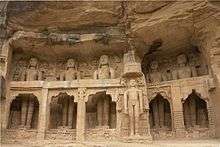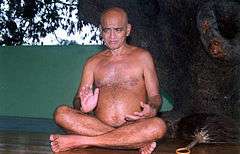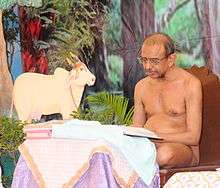Digambara

| Part of a series on |
| Jainism |
|---|
 |
|
Jain prayers |
|
Ethics |
|
Major figures |
|
Major sects |
|
Festivals |
|
Pilgrimages |
|
|
Digambara (/dɪˈɡʌmbərə/; "sky-clad") is one of the two major schools of Jainism, the other being Śvētāmbara (white-clad). The word Digambara (Sanskrit) is a combination of two words: dig (directions) and ambara (clothes), referring to those whose garments are of the element that fills the four quarters of space. Digambara monks do not wear any clothes. The monks carry picchi, a broom made up of fallen peacock feathers (for clearing the place before walking or sitting), kamandalu (a water gourd), and shastra (scripture). One of the most important scholar-monks of Digambara tradition was Kundakunda. He authored Prakrit texts such as the Samayasāra and the Pravacanasāra. Other prominent Acharyas of this tradition were, Virasena (author of a commentary on the Dhavala), Samantabhadra and Siddhasena Divakara. The Satkhandagama and Kasayapahuda have major significance in the Digambara tradition.
Monasticism
The word Digambara is a combination of two Sanskrit words: dik (दिक्) (directions) and ambara ( अम्बर ) (clothes), referring to those whose garments are of the element that fills the four quarters of space.[1] Digambara monks do not wear any clothes as it is considered to be parigraha (possession), which ultimately leads to attachment.[2] A Digambara monk has 28 mūla guņas (primary attributes).[3] These are: five mahāvratas (supreme vows); five samitis (regulations); pañcendriya nirodha (five-fold control of the senses); Şadāvaśyakas (six essential duties); and seven niyamas (rules or restrictions).[4]
| Head | Vow | Meaning |
|---|---|---|
| Mahavratas- Five Great Vows[5][6] |
1. Ahimsa | Not to injure any living being through actions or thoughts |
| 2. Truth | To speak only the truth and good words | |
| 3. Asteya | Not to take anything unless given | |
| 4. Brahmacharya | Celibacy in action, words and thoughts | |
| 5. Aparigraha | Renunciation of worldly things and foreign natures, external and internal | |
| Samiti- Fivefold regulation of activities[7][8] |
6. irya | To walk carefully after viewing land to the extent of four cubits (2 yards). |
| 7. bhasha | Not to criticise anyone or speak bad words | |
| 8. eshna | To accept food from a sravaka (householder) if it is free from 46 faults | |
| 9. adan-nishep | Carefulness in the handling of whatever the saint possess. | |
| 10. pratishṭapan | To dispose off the body waste at a place free from living beings. | |
| Panchindrinirodh[4] | 11–15. Fivefold control of the senses | Shedding all attachment and aversion towards the sense objects pertaining to touch (sparśana), taste (rasana), smell (ghrāṇa), sight (cakśu), and hearing (śrotra) |
| Six Essential Duties[9][4] | 16. Sāmāyika | Meditate for equanimity towards every living being |
| 17. stuti | Worship of the Tirthankaras | |
| 18. vandan | To pay obeisances to siddhas, arihantas and acharyas | |
| 19. Pratikramana | Self-censure, repentance; to drive oneself away from the multitude of karmas, virtuous or wicked, done in the past. | |
| 20. Pratikhayan | Renunciation | |
| 21. Kayotsarga | Giving up attachment to the body and meditate on soul. | |
| Niyama- Seven rules[4][10] |
22. adantdhavan | Not to use tooth powder to clean teeth |
| 23. bhushayan | Sleeping on hard ground | |
| 24. asnāna | Non-bathing | |
| 25. stithi-bhojan | Eating food in standing posture | |
| 26. ahara | To consume food and water once a day | |
| 27. keśa-lonch | To pluck hair on the head and face by hand. | |
| 28. nudity | To be nude (digambara) | |
The monks carry picchi, a broom made up of fallen peacock feathers for removing small insects without causing them injury, Kamandalu (the gourd for carrying pure, sterilized water) and shastra (scripture).[11][12] The head of all monastics is called Āchārya, while the saintly preceptor of saints is the upādhyāya.[13] The Āchārya has 36 primary attributes (mūla guņa) in addition to the 28 mentioned above.[4] The monks perform kayotsarga daily, in a rigid and immobile posture, with the arms held stiffly down, knees straight, and toes directed forward.[1] Female monastics in Digambara tradition are known as aryikas.[14]
Lineage

According to Digambara texts, after liberation of the Lord Mahavira, three Anubaddha Kevalīs attained Kevalajñāna (omniscience) sequentially – Gautama Gaņadhara, Acharya Sudharma, and Jambusvami in next 62 years.[15] During the next hundred years, five Āchāryas had complete knowledge of the scriptures, as such, called Śruta Kevalīs, the last of them being Āchārya Bhadrabahu.[16][17] Spiritual lineage of heads of monastic orders is known as Pattavali.[18]
| Acharyas | Time period | Known for |
|---|---|---|
| Bhadrabahu | 3rd century BC | Last Shruta Kevalin and Chandragupta Maurya's spiritual teacher[16] |
| Kundakunda | 1st century B.C.- 1st century C.E. | Author of Samayasāra, Niyamasara, Pravachansara, Barah anuvekkha[19] |
| Umaswami | 2nd century AD | Author of Tattvartha Sutra (canon on science and ethics) |
| Samantabhadra | 2nd century AD | Author of Ratnakaranda śrāvakācāra, Aptamimamsa |
| Siddhasena Divakara | 5th century AD | Author of Sanmatitarka[20] |
| Pujyapada | 5th century AD | Author of Iṣṭopadeśa (Divine Sermons), a concise work of 51 verses |
| Manatunga | 6th century AD | Creator of famous Bhaktamara Stotra |
| Virasena | 8th-century AD | Mathematician and author of Dhavala[21] |
| Jinasena | 9th century AD | Author of Mahapurana |
| Nemichandra | 10th century AD | Author of Dravyasamgraha and supervised the consecration of the Gomateshwara statue. |
The Digambara tradition was divided into two main orders:[22]
- Mula Sangha, which includes Sena Gana, Deshiya Gana and Balatkara Gana traditions
- Kashtha Sangha, which includes the Mathura Gana and Lat-vagad Gana traditions
The Bhattarakas of Shravanabelagola and Mudbidri belong to Deshiya Gana and the Bhattaraka of Humbaj belongs to the Balatkara Gana.[23]
Historicity
Relics found from Harrapan excavations like seals depicting Kayotsarga posture, idols in Padmasana and a nude bust of red limestone give insight about the antiquity of the Digambara tradition.[24] The presence of gymnosophists (naked philosophers) in Greek records as early as the fourth century BC, supports the claim of the Digambaras that they have preserved the ancient Śramaṇa practice.[1]
Worship

The Digambara Jains worship completely nude idols of tirthankaras (omniscient beings) and siddha (liberated souls). The tirthankara is represented either seated in yoga posture or standing in the Kayotsarga posture.[25]
The truly "sky-clad" (digambara) Jaina statue expresses the perfect isolation of the one who has stripped off every bond. His is an absolute "abiding in itself," a strange but perfect aloofness, a nudity of chilling majesty, in its stony simplicity, rigid contours, and abstraction.[26]
Statues
- Kizhavalavu (Keelavalavu) Sculptures

 Tirthankara statues, Gwalior Fort, Madhya Pradesh
Tirthankara statues, Gwalior Fort, Madhya Pradesh Tirthankara Parshvanatha statue, Rajasthan
Tirthankara Parshvanatha statue, Rajasthan
Scriptures
The Digambara sect of Jainism rejects the authority of the texts accepted by the other major sect, the Svetambaras.[27]
According to the Digambaras, Āchārya Dharasena guided two Āchāryas, Pushpadanta and Bhutabali, to put the teachings of Mahavira in written form, 683 years after the nirvana of Mahavira.[28] The two Āchāryas wrote Ṣaṭkhaṅḍāgama on palm leaves which is considered to be among the oldest known Digambara texts.[29] Āchārya Bhutabali was the last ascetic who had partial knowledge of the original Jain Agamas. Later on, some learned Āchāryas started to restore, compile and put into written words the teachings of Lord Mahavira, that were the subject matter of Agamas.[17]
Digambaras group the texts into four literary categories called anuyoga (exposition).[30] The prathmanuyoga (first exposition) contains the universal history, the karananuyoga (calculation exposition) contains works on cosmology and the charananuyoga (behaviour exposition) includes texts about proper behaviour for monks and Sravakas.[30]
Differences with Śvētāmbara sect
According to Digambara texts, after attaining Kevala Jnana (omniscience), arihant (omniscient beings) are free from human needs like hunger, thirst, and sleep.[31] According to the Digambara tradition, a soul can attain moksha (liberation) only from the male body with complete nudity being a necessity.[32]
Sub-sects
Digambaras are divided into various sub-sects viz. Terapanthi, Bispanthi, Taranpanthi (or Samayiapanthi),[33] Gumanapanthi and Totapanthi.[34]

Terapanthi

The Terapanthis worship the idols with ashta-drava viz. jal (water), chandan (sandal), akshata (sacred rice), pushp (yellow rice), deep (yellow dry coconut), dhup (kapoor or cloves) and fal (almonds).[34] Terapanthi is a reformist sect of Digambara Jainism that distinguished itself from the Bispanthi sect. It formed out of strong opposition to the religious domination of traditional religious leaders called bhattarakas during 12–16th century A.D. They oppose the worship of various minor gods and goddesses. Some Terapanthi practices, like not using flowers in worship, gradually spread throughout most of North Indian Jainism as well. Terapanthis occur in large numbers in Rajasthan, Uttar Pradesh and Madhya Pradesh.[34]
Bispanthi
Besides tirthankaras, Bispanthi also worship Yaksha and Yakshini like Bhairava and Kshetrapala. Their religious practices include aarti and offerings of flowers, fruits and prasad. Bhattarakas are their dharma-gurus and they are concentrated in Rajasthan and Gujarat.[34]
See also
- Nudity in religion
- God in Jainism
- Kshullak
- Jain Philosophy
- Timeline of Jainism
- Digambar Jain Mahasabha
Notes
- 1 2 3 Zimmer 1953, p. 210.
- ↑ Dundas 2002, p. 45.
- ↑ Pramansagar 2008, p. 189–191.
- 1 2 3 4 5 Vijay K. Jain 2013, pp. 189-191, 196-197.
- ↑ Vijay K. Jain 2011, p. 93–100.
- ↑ Champat Rai Jain 1926, p. 26.
- ↑ Vijay K. Jain 2012, p. 144-145.
- ↑ Champat Rai Jain 1926, p. 32-38.
- ↑ Vijay K. Jain 2012, p. 143.
- ↑ Champat Rai Jain 1926, p. 46-47.
- ↑ Upinder Singh 2009, p. 316.
- ↑ Champat Rai Jain 1926, p. 36.
- ↑ Champat Rai Jain 1926, p. 21.
- ↑ Champat Rai Jain 1926, p. 141.
- ↑ Vijay K. Jain 2012, p. xi-xii.
- 1 2 Pereira 1977, p. 5.
- 1 2 Vijay K. Jain 2012, p. xii.
- ↑ Cort 2010, p. 335.
- ↑ Jaini 1991, p. 31.
- ↑ Upinder Singh 2009, p. 524.
- ↑ Satkhandagama : Dhaval (Jivasthana) Satparupana-I (Enunciation of Existence-I) An English Translation of Part 1 of the Dhavala Commentary on the Satkhandagama of Acarya Pushpadanta & Bhutabali Dhavala commentary by Acarya Virasena English tr. by Prof. Nandlal Jain, Ed. by Prof. Ashok Jain ISBN 978-81-86957-47-9
- ↑ Sangave 1980, p. 56.
- ↑ Sangave 1980, p. 299.
- ↑ Possehl, Gregory L. (2002), The Indus Civilization: A Contemporary Perspective, Rowman Altamira, p. 111, ISBN 978-0-7591-0172-2
- ↑ Zimmer 1953, p. 209–210.
- ↑ Zimmer 1953, p. 213.
- ↑ Upinder Singh 2009, p. 444.
- ↑ Dundas 2002, p. 79.
- ↑ Dundas 2002, pp. 63–64.
- 1 2 Dundas 2002, p. 80.
- ↑ Upinder Singh 2009, p. 314.
- ↑ Upinder Singh 2009, p. 319.
- ↑ Sangave 1980, p. 51.
- 1 2 3 4 Sangave 1980, p. 52.
References
- Jain, Vijay K. (2013), Ācārya Nemichandra's Dravyasaṃgraha, Vikalp Printers, ISBN 9788190363952,
 This article incorporates text from this source, which is in the public domain.
This article incorporates text from this source, which is in the public domain. - Jain, Vijay K. (2012), Acharya Amritchandra's Purushartha Siddhyupaya, Vikalp Printers, ISBN 81-903639-4-8,
 This article incorporates text from this source, which is in the public domain.
This article incorporates text from this source, which is in the public domain. - Jain, Vijay K. (2011), Acharya Umasvami's Tattvārthsūtra (1st ed.), (Uttarakhand) India: Vikalp Printers, ISBN 81-903639-2-1,
 This article incorporates text from this source, which is in the public domain.
This article incorporates text from this source, which is in the public domain. - Pramansagar, Muni (2008), Jain Tattva-Vidya, India: Bhartiya Gyanpeeth, ISBN 978-81-263-1480-5
- Singh, Upinder (2009), A History Of Ancient And Early Medieval India: From The Stone Age To The 12Th Century, Pearson Education, ISBN 978-81-317-1120-0
- Jones, Constance; Ryan, James D. (2006), Encyclopedia of Hinduism, Infobase Publishing, ISBN 978-0-8160-7564-5
- Dundas, Paul (2002) [1992], The Jains (Second ed.), Routledge, ISBN 0-415-26605-X
- Jaini, Padmanabh S. (1991), Gender and Salvation: Jaina Debates on the Spiritual Liberation of Women, University of California Press, ISBN 0-520-06820-3
- Pereira, José (1977), Monolithic Jinas, Motilal Banarsidass, ISBN 0-8426-1027-8
- Mookerji, Radha Kumud (1988) [first published in 1966], Chandragupta Maurya and his times (4th ed.), Motilal Banarsidass, ISBN 81-208-0433-3
- Sangave, Vilas Adinath (1980) [1959], Jaina Community: A Social Survey, Popular Prakashan, ISBN 0317123467
- Cort, John (2010) [1953], Framing the Jina: Narratives of Icons and Idols in Jain History, Oxford University Press, ISBN 978-0-19-538502-1
- Zimmer, Heinrich (1953) [April 1952], Campbell, Joseph, ed., Philosophies Of India, London, E.C. 4: Routledge & Kegan Paul Ltd, ISBN 978-81-208-0739-6,
 This article incorporates text from this source, which is in the public domain.
This article incorporates text from this source, which is in the public domain. - Jain, Champat Rai (1926), Sannyasa Dharma